Art prints are available in a wide range of prices, influenced by factors such as quality, size, and the artist’s reputation. They can be categorized into low-end, mid-range, and high-end segments, each offering distinct styles and qualities. Additionally, understanding the various types of art prints and their production methods is essential for making an informed choice that aligns with your needs and budget.
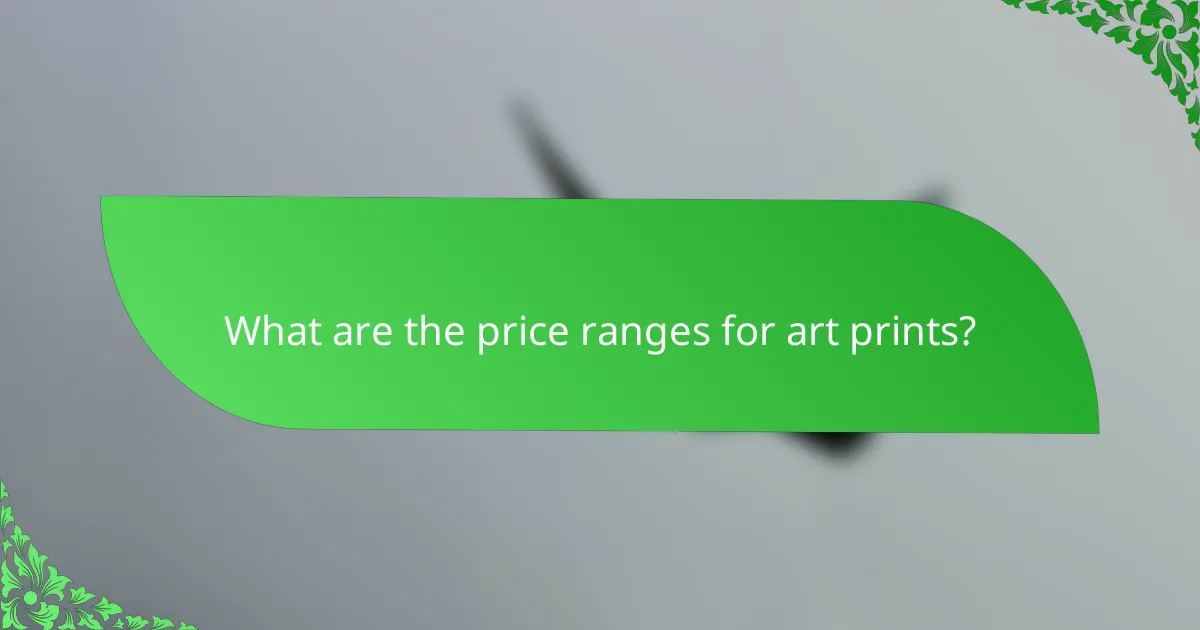
What are the price ranges for art prints?
The price ranges for art prints vary significantly based on factors like quality, size, and the artist’s reputation. Generally, you can expect to find art prints categorized into low-end, mid-range, and high-end segments, each offering different qualities and styles.
Low-end art prints ($10-$50)
Low-end art prints typically range from $10 to $50 and are often mass-produced. These prints may be made using lower-quality materials, such as standard paper or ink, which can affect their longevity and visual appeal.
Common sources for low-end prints include online retailers, local shops, and art fairs. While they may not offer the same level of detail or vibrancy as higher-priced options, they can be a budget-friendly way to decorate your space.
Mid-range art prints ($50-$150)
Mid-range art prints fall between $50 and $150, often featuring better quality materials and printing techniques. These prints may be produced in limited editions, enhancing their value and uniqueness.
Artists and reputable galleries typically offer mid-range prints, which can include giclée prints or screen prints. Investing in this category can provide a balance between affordability and quality, making them suitable for collectors and casual buyers alike.
High-end art prints ($150 and above)
High-end art prints start at $150 and can go well beyond that, often featuring exclusive editions or original works. These prints are usually made with archival-quality materials, ensuring durability and vibrant colors that last for years.
Purchasing high-end prints often involves direct transactions with artists or established galleries, providing an opportunity to acquire unique pieces. This category is ideal for serious collectors or those looking to make a statement with their art selection.
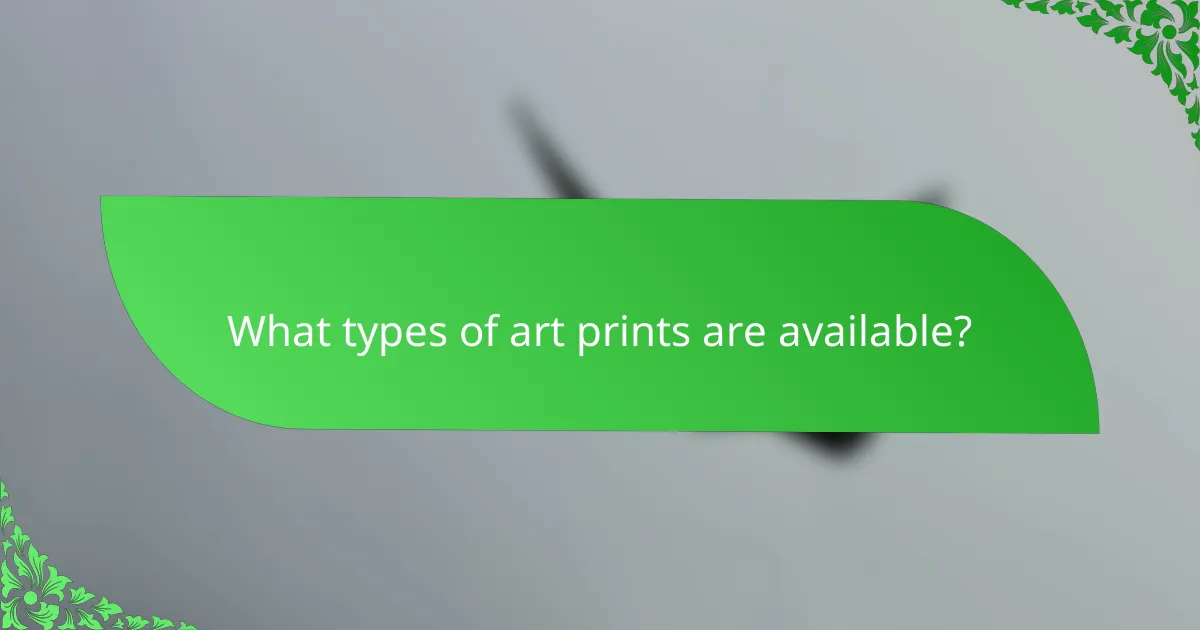
What types of art prints are available?
Art prints come in various types, each with unique characteristics and production methods. Understanding these types can help you choose the right print for your needs and budget.
Giclée prints
Giclée prints are high-quality reproductions created using inkjet technology, which allows for a wide color range and fine detail. They are often printed on archival paper or canvas, making them durable and suitable for long-term display.
Prices for giclée prints can vary significantly, typically ranging from around $30 to several hundred dollars, depending on the artist and size. When purchasing, look for prints that specify archival inks and papers to ensure longevity.
Screen prints
Screen prints, or silkscreen prints, involve pushing ink through a stencil on a mesh screen. This method allows for vibrant colors and textures, making it popular among contemporary artists.
Screen prints are generally more affordable, with prices ranging from $20 to $200. Consider the edition size, as limited editions can increase value. Ensure the print is signed by the artist for authenticity.
Lithographs
Lithographs are created using a printing process that involves drawing on a stone or metal plate with a greasy medium. This technique produces a unique texture and quality that is distinct from other print types.
Prices for lithographs can vary widely, often starting around $50 and going up to several thousand dollars for original works. Look for prints that are part of a limited edition, as these tend to hold their value better over time.
Canvas prints
Canvas prints are reproductions printed directly onto canvas material, giving them a textured appearance similar to original paintings. They are often stretched over a frame, making them ready to hang.
Canvas prints typically range from $40 to $300, depending on size and quality. When selecting a canvas print, check for high-resolution images and quality inks to ensure a vibrant finish that lasts.
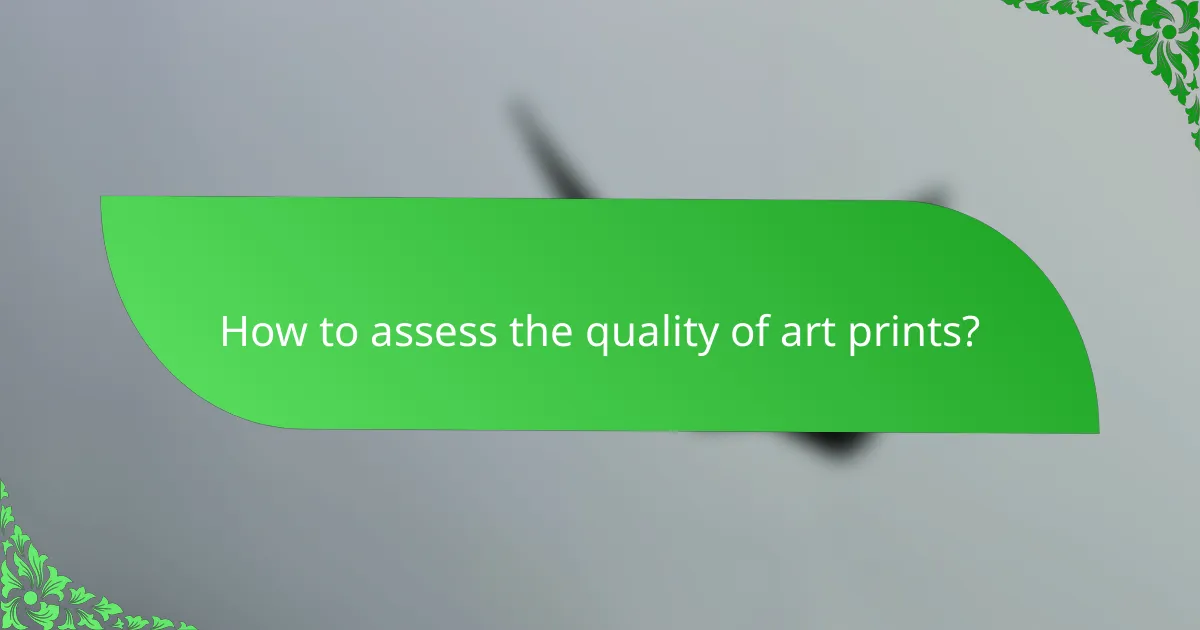
How to assess the quality of art prints?
To assess the quality of art prints, consider factors such as material quality, print resolution, and color accuracy. These elements significantly influence the overall appearance and longevity of the print.
Material quality
The material quality of an art print refers to the type of paper or canvas used. High-quality prints are typically made on acid-free paper or archival-grade canvas, which helps prevent deterioration over time.
When evaluating material, look for prints that specify their weight in grams per square meter (gsm). A weight of around 200 gsm or higher is generally considered good for paper prints.
Print resolution
Print resolution is measured in dots per inch (DPI) and indicates the detail an image holds. A resolution of at least 300 DPI is recommended for high-quality art prints, ensuring sharp and clear images.
Lower resolutions may lead to pixelation, especially in larger prints. Always check the DPI before purchasing to ensure the print will look crisp at your desired size.
Color accuracy
Color accuracy refers to how closely the printed colors match the original artwork. Look for prints that use high-quality inks and are printed using professional techniques to achieve vibrant and true-to-life colors.
Some prints may undergo color calibration processes to ensure fidelity. If possible, request a sample or view the print under different lighting conditions to assess color performance before making a purchase.
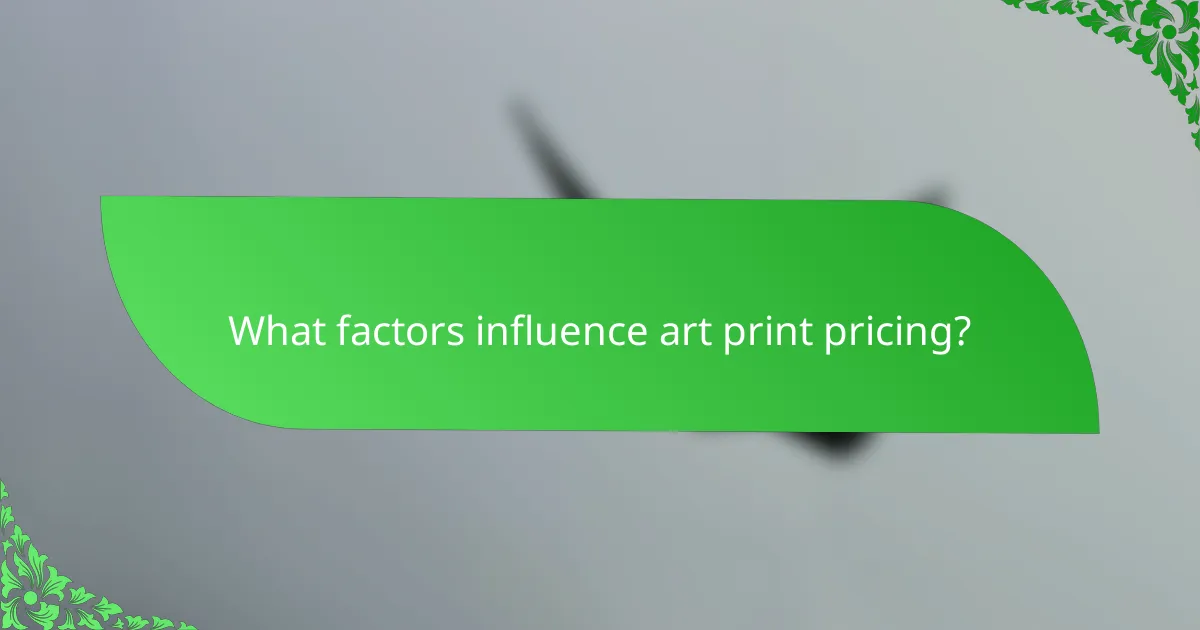
What factors influence art print pricing?
Art print pricing is influenced by several key factors, including the artist’s reputation, the size of the print, and the edition size. Understanding these elements can help buyers make informed decisions and find prints that fit their budget and aesthetic preferences.
Artist reputation
The reputation of the artist plays a significant role in determining the price of an art print. Established artists with a strong following or notable exhibitions often command higher prices due to demand and perceived value. Emerging artists may offer more affordable options, allowing collectors to explore new talent without a hefty investment.
When considering an artist’s reputation, look for their exhibition history, awards, and previous sales. A well-documented career can indicate potential future value, making it worthwhile to invest in their work early on.
Print size
The size of an art print directly affects its pricing, with larger prints typically costing more than smaller ones. This is due to the increased material costs and the impact of size on visual presence. For instance, a small print might range from $20 to $100, while larger prints can start in the low hundreds and go up significantly.
When selecting a print size, consider where you plan to display it. Larger prints can serve as focal points in a room, while smaller prints may work better in groupings or more intimate spaces. Always measure your wall space to ensure a good fit.
Edition size
The edition size refers to the number of prints produced from a single artwork. Limited editions, which may consist of only a few dozen prints, often carry higher prices due to their scarcity. In contrast, open editions, which can be produced indefinitely, tend to be more affordable.
When purchasing art prints, inquire about the edition size and whether the print is signed or numbered. A signed, limited edition print can be a more valuable investment compared to an unsigned, open edition. Understanding these details can enhance your collecting experience and help you make more strategic choices.
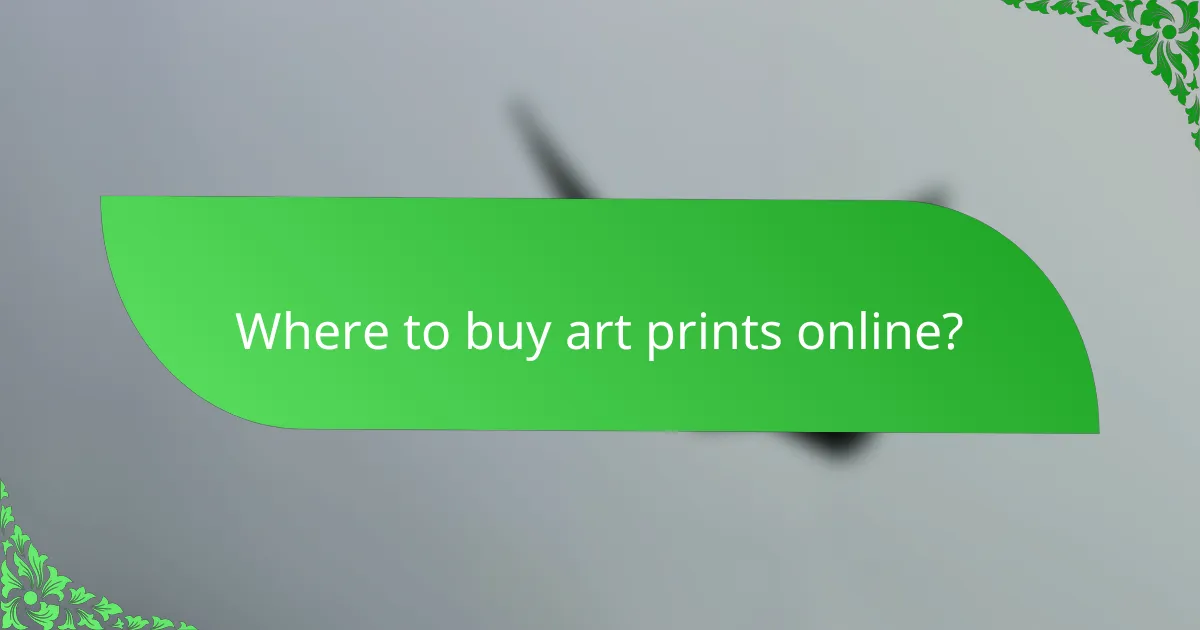
Where to buy art prints online?
You can purchase art prints online from various platforms that cater to different tastes and budgets. Popular options include art marketplaces, specialty retailers, and direct purchases from artists’ websites, each offering unique selections and price ranges.
Art marketplaces (e.g., Etsy)
Art marketplaces like Etsy provide a platform for independent artists to sell their work directly to consumers. Prices for art prints on these sites can vary widely, typically ranging from around $10 to several hundred dollars, depending on the artist’s reputation and the print’s size and quality.
When shopping on marketplaces, consider the seller’s ratings and reviews to ensure a positive buying experience. Look for options like custom prints or limited editions, which can enhance the uniqueness of your purchase.
Specialty art retailers (e.g., Saatchi Art)
Specialty art retailers such as Saatchi Art focus on curated collections of art prints, often featuring established and emerging artists. Prices here can start from approximately $50 and go up to thousands, especially for limited edition or high-quality prints.
These retailers usually offer additional services like framing and shipping, which can simplify the buying process. Check for return policies and authenticity guarantees to ensure you are making a sound investment.
Direct from artists’ websites
Buying art prints directly from artists’ websites allows you to support creators while often accessing exclusive works. Prices can range from about $20 for smaller prints to several hundred dollars for larger or more intricate pieces.
When purchasing directly, you may find unique offerings such as signed prints or original works. Always verify the artist’s credentials and look for secure payment options to protect your transaction.

How to choose the right art print for your space?
Choosing the right art print involves considering your personal style, the existing decor, and the atmosphere you want to create. Focus on the size, color palette, and subject matter of the print to ensure it complements your space effectively.
Consider room aesthetics
Room aesthetics play a crucial role in selecting an art print. Evaluate the colors, textures, and overall design theme of the room. For instance, a modern minimalist space may benefit from abstract prints, while a cozy, traditional room might be enhanced by classic landscapes or portraits.
Think about the scale of the art print in relation to the room. Large prints can serve as focal points in spacious areas, while smaller prints can be grouped together to create a gallery wall effect. Aim for a balance that feels harmonious and visually appealing.
Additionally, consider the mood you want to evoke. Bright, vibrant prints can energize a space, while softer, muted tones can create a calming atmosphere. Choose prints that resonate with the emotions you wish to convey in your environment.
